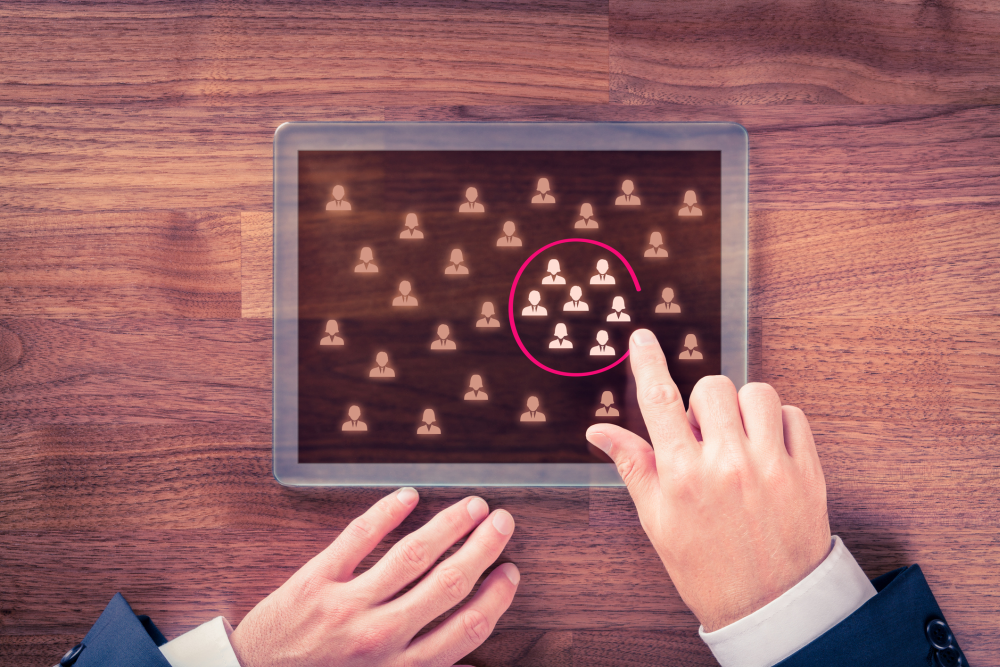
It is getting tough to generate ecommerce sales because your buyers have a lot of options to choose from. Generating more sales is the top priority of 71% companies.
While there are several ways to boost ecommerce sales, nothing beats email marketing.
The daily email traffic in 2017 was 269 billion. This means 269 billion emails were sent every single day. Your email can easily get lost or ignored or deleted or moved to trash.
This is why email list segmentation is used to send personalized emails that subscribers love interacting with. Email statistics show that as much as 77% of email marketing ROI is generated from segmented email campaigns.
According to MailChimp, segmented email campaigns have 14.31% higher open rate, 10.64% higher unique opens, and 100.95% higher clicks.
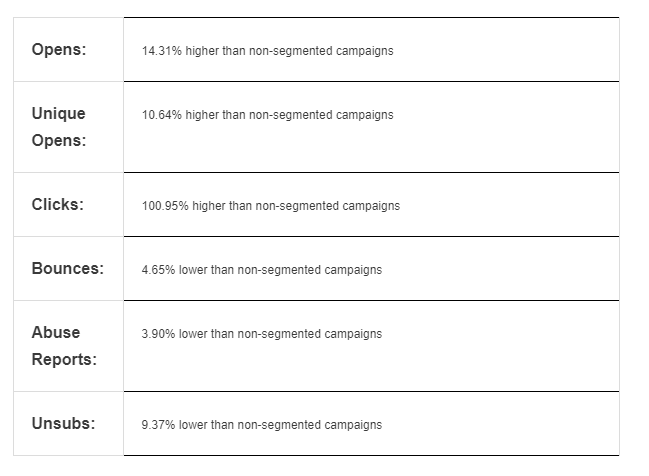
Segmenting email list has several benefits such as:
- It makes emails personalized.
- It increases sales.
- Increases revenue.
- Increases open rate and click-through rate.
- Increases subscriber engagement.
- Reduces unsubscribes.
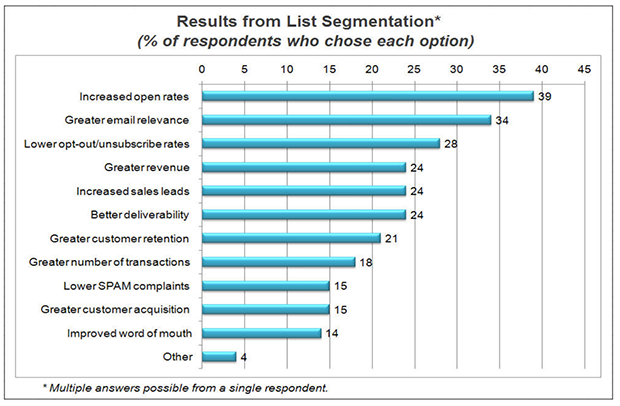
List segmentation makes your emails relevant that subscribers cannot resist opening, reading, clicking, and taking action.
To help you get started with list segmentation for your ecommerce store to boost sales, check out these 18 list segmentation ideas and techniques.
-
Demographics
It is the oldest list segmentation technique that is based on quantifiable statistical data related to your subscribers such as age, gender, marital status, race, nationality, income, education, family size, social class, etc.
Being old doesn’t mean demographic segmentation doesn’t work. Johnny Cupcakes increased its revenue per campaign by 141% after segmenting its list of 80K customers. Here is a creative that was sent to male subscribers.
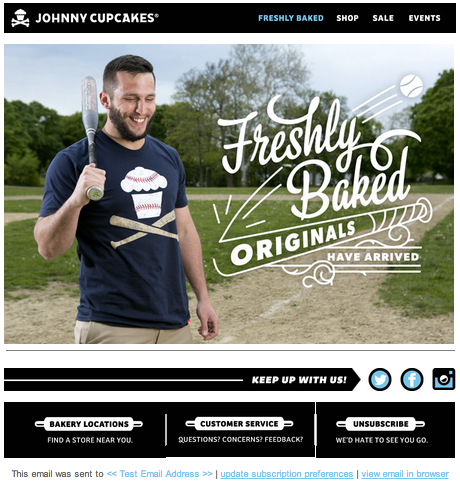
And this is the email creative sent to females.
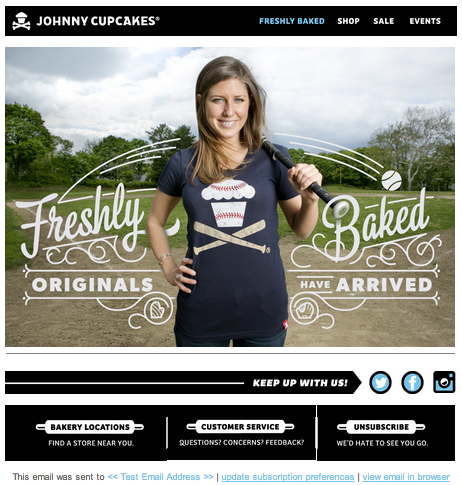
The clothing retailer increased its click-through rate by 42% and conversion rate by 123%.
Brands like Adidas use dynamic content in emails that make campaigns more relevant and personalized. With its Original series, Adidas uses gender-based targeting to ensure subscribers see products in their inbox that’s relevant to them.
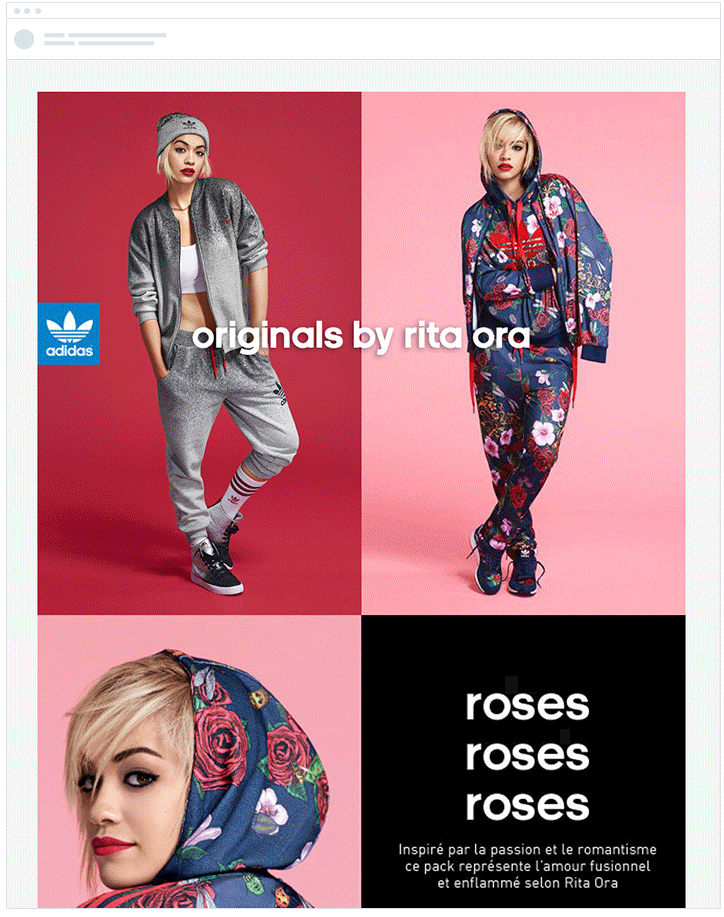
Segmenting your email list on the basis of demographics provide you with tons of options as there are a lot of variables to choose from. You can use gender and age or you can go deep by segmenting on the basis of income, nationality, and social class. Needless to say, you can use multiple variables to create several segments.
For instance, married females under 35 who are college graduates and have a monthly income between $5K and $10K.
-
Geography
Imagine you end up sending your new product to subscribers who are living in a location where your ‘product’ isn’t available yet.
This is embarrassing.
Segmenting your list on subscribers geographical location helps you send right email to the right subscribers based on their current location.
Litmus sent segmented emails while promoting its Email Design Conference. They targeted subscribers in three regions: San Francisco, Boston, and London. Based on where subscribers opened their last email, Litmus was able to identify subscribers in these three locations.
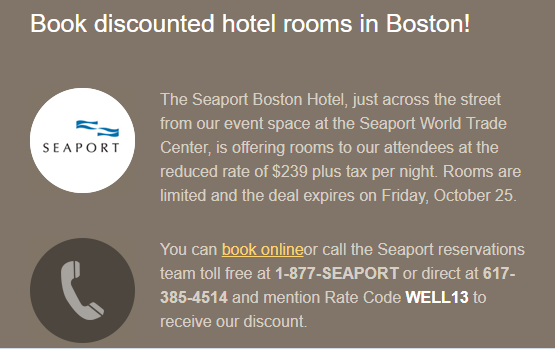
These targeted emails increased open rate by 68% up from 22%. They sold 58 tickets with the help of these targeted emails.
If you sell in multiple countries, why not send segmented emails based on specific location-based variables like events, new arrivals, current happenings, political events, and more.
-
Past purchase
Segment your customers based on their past purchase(s). This is how you can send them related products that they might need.
It is a bit tricky. Do it smartly.
I recently purchased a wireless mouse from AliExpress, and this is the email I received a few days later.
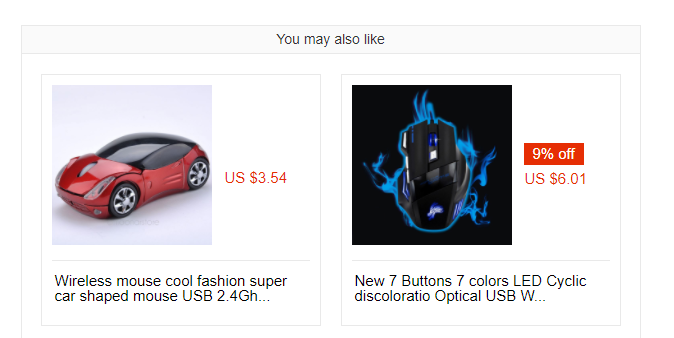
I already purchased a wireless mouse and I don’t need a new one right now.
Not impressive stuff.
Past purchases should be used to send relevant cross-sells and upsells. If you'll send a similar product, it won’t work because your customer already has it.
Get creative.
For instance, you can send cross-sells, upsells, and upgrades to your customers based on their last purchase. This is how Amazon uses the current purchase to persuade its customers to shop for related products.

They don’t ask you to buy more of the same stuff but they show you what you should buy for the best experience. This is how you should use your customer’s past purchases to send them related offers that they cannot deny.
-
Purchase frequency
Segment your list based on how frequently customers buy from your store. This will help you increase shopping frequency and you can reward your most frequent buyers with special discounts and other perks.
Or, you can send an email to one-time buyers to encourage them to shop again.
There is so much that you can do with buying frequency segmentation.
You need to start by finding your store’s purchase frequency which refers to the number of times an average customer makes a purchase within a specific time duration (say a year).

This will help you differentiate customers based on their purchase frequencies. For instance, if the average purchase frequency of your store is 4/year, you can push customers who are running behind by sending them coupons and customized offers.
Another relevant metric is ‘time between purchases’ that shows you the time before a customer makes a purchase again.

This will help you create targeted email campaigns. If, for instance, the time between purchases is 3 weeks, you can start sending emails to customers’ during the second week to make sure they buy again on time.
-
Purchase history
Purchase history is more detailed than past purchase. It focuses on a customer’s entire purchase history. Understanding purchase history can help you increase repurchase and boost engagement.
There are three ways you can use purchase history to increase ecommerce sales:
- Encourage repurchase to reduce the time between purchases.
- Future purchase prediction.
- Reward customers based on their history (such as a loyalty program).
Birchbox sent this email to Carly Stec based on her purchase history (and sample). Not just that they made it transparent but this email is super-personalized.

Result?
Carly subscribed to Birchbox and she is one loyal customer.
-
Purchase interests
Segmenting lists on the basis of purchase interest is a great way to increase sales because every email gets clicked. Understanding your customer’s purchase interests isn’t easy, however.
Purchase history and last purchase are poor predictors of what interests your customers.
Refer back to the email I received from AliExpress.
Buying a wireless mouse doesn’t define my interest. I purchased a mouse because I needed it. That’s it. This is all what the transaction was. I'm not buying a new mouse until I break this one.
The best approach to identify your customer’s purchase interests is to ask them.
This is how Amazon asks its subscribers about their interests.
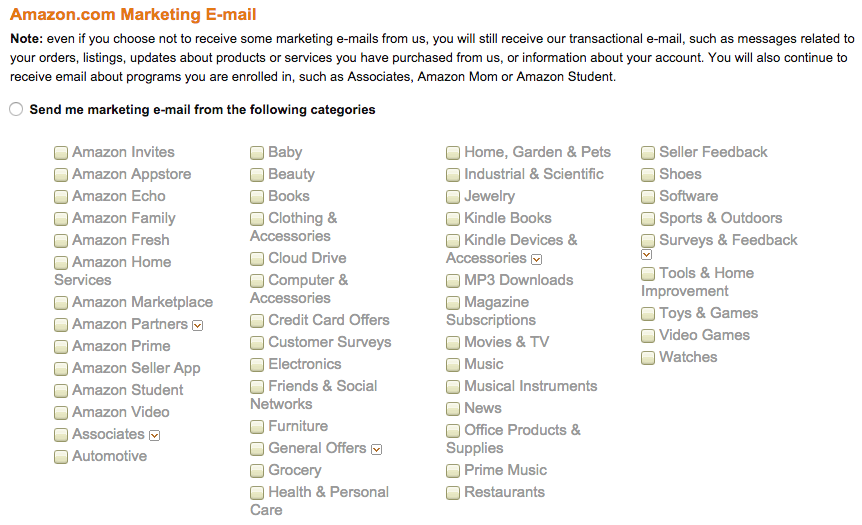
Here is an example of a survey email from The Path.
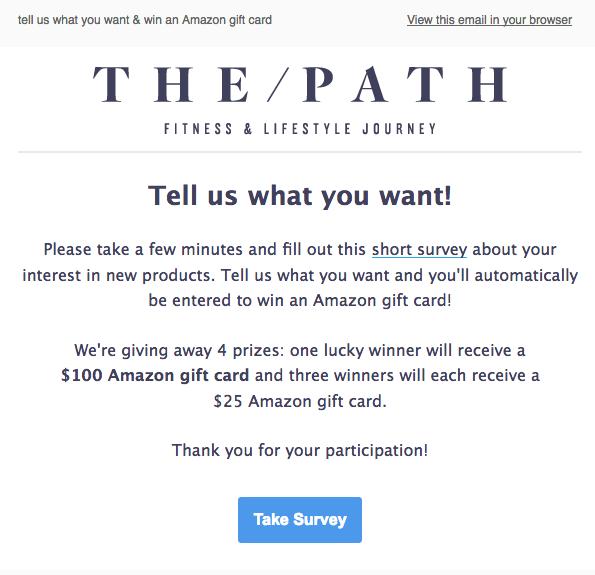
Ask your subscribers to update their email preferences so you can send them relevant and personalized emails based on their interests.
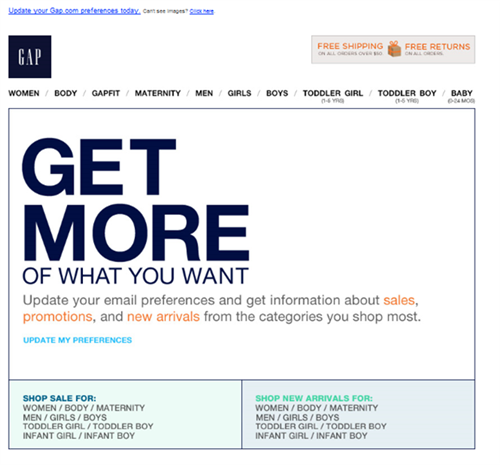
Besides, how subscribers respond to your emails (and offers) tells you what they like. The data that you have will show you the purchase interests of a specific customer.
For instance, if a subscriber never clicks any jacket offers and always clicks perfume offers, you know what to send him.
There are certain industries where identifying purchase interests is extremely easy. Spotify knows its customers inside out so it doesn’t need to conduct surveys. It sends personalized and targeted emails to its subscribers.
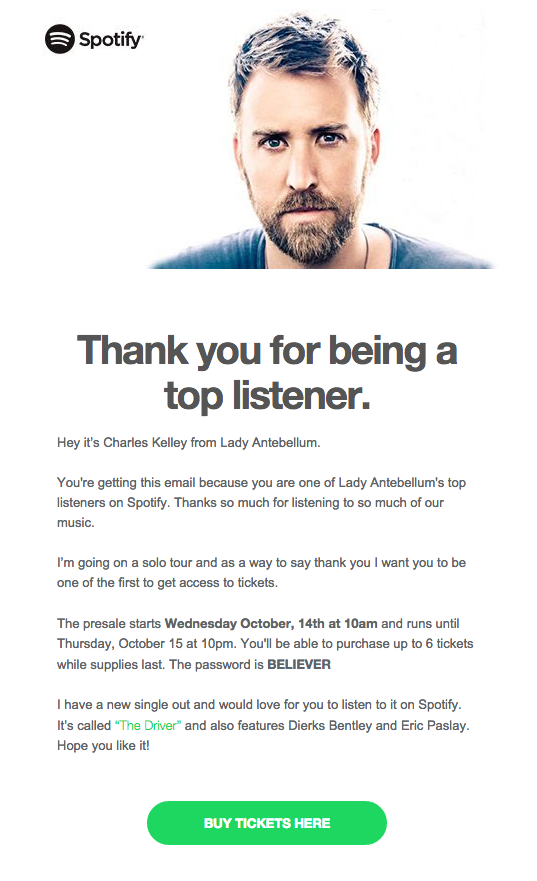
If you’re in a similar industry, you’re one lucky champ.
-
Purchase cycle
Do you offer products that customers buy in cycles? Are there any customers who buy from you on a weekly or monthly basis?
For instance, there are people who buy high ticket items during Christmas.
Segmenting customers based on their purchase cycle and when they will buy from you again is a great technique to increase sales.
For instance, send an email to customers who purchased a perishable product reminding them to buy a new one.
This is an email that Belk sends out to its customers reminding them to restock their K-cups and intelligently promotes related products.
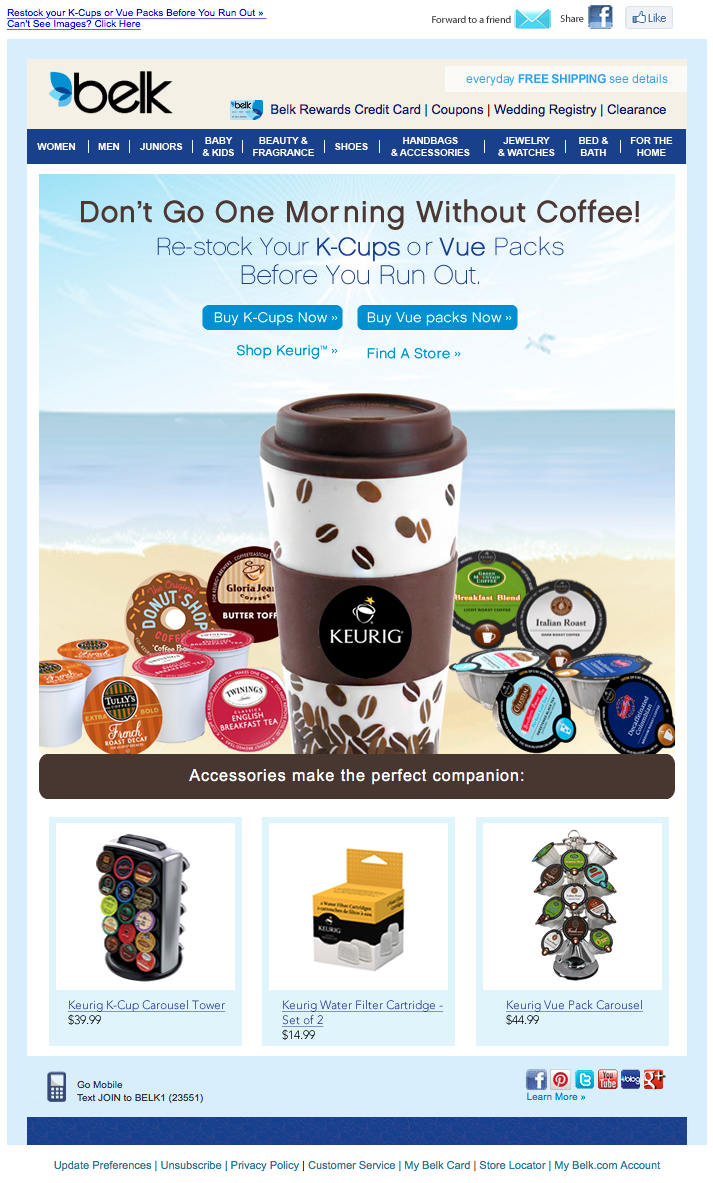
These types of emails don’t just drive revenue but help you build a strong relationship with your list.
-
Change in buying behavior
The buying pattern of your customers changes over time. Based on their current buying behavior, segment them, move them to appropriate lists, and start sending emails to bring them back.
Some customers will lose interest in your store while others will start buying more. Segment each group accordingly.
This is an email that Pinkberry sends to its subscribers when they're planning to switch.
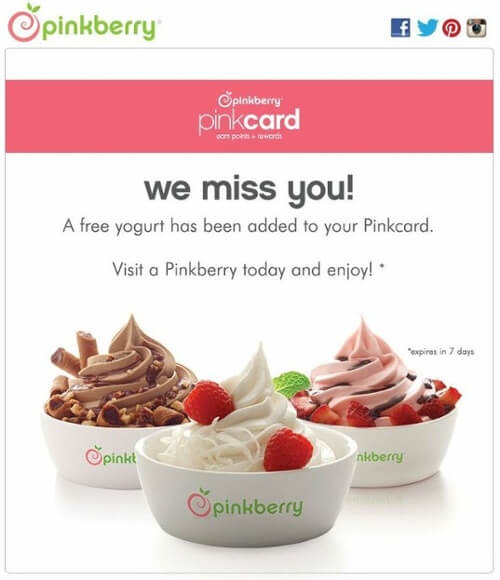 A change in buying behavior is an opportunity for your store. Even if you cannot bring your customers back, you can send a quick email asking them why they lost interest in your store. This will provide you with data that can be used to reduce churn.
A change in buying behavior is an opportunity for your store. Even if you cannot bring your customers back, you can send a quick email asking them why they lost interest in your store. This will provide you with data that can be used to reduce churn.
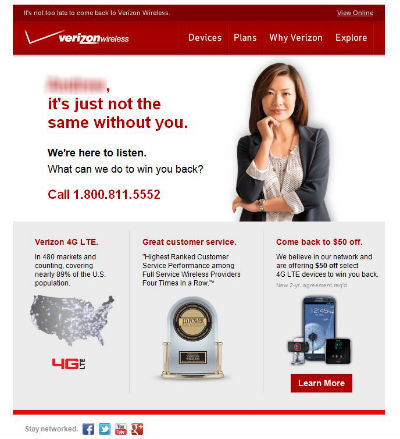
-
Cart abandonment
This is one heck of an issue with ecommerce stores and if you don’t segment your list on the basis of cart abandonment, you’re losing customers (and sales). Statistics show that 68% of shopping carts are abandoned.
Sending an email to remind your subscribers of items they left in the cart is the best approach to generate sales.
Here is how Doggyloot does it in style.
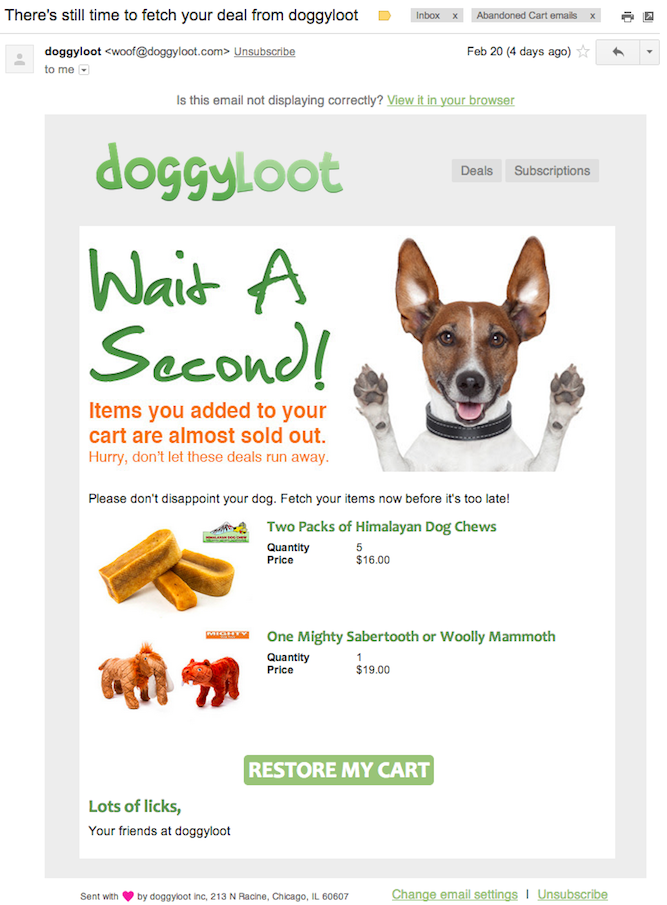 If you don’t get a response with the first email, send another email with an incentive.
If you don’t get a response with the first email, send another email with an incentive.
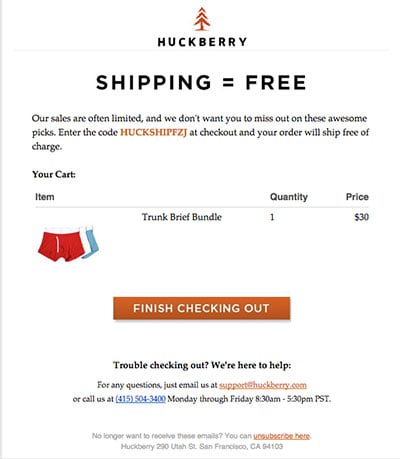 Or maybe offer them more options.
Or maybe offer them more options.
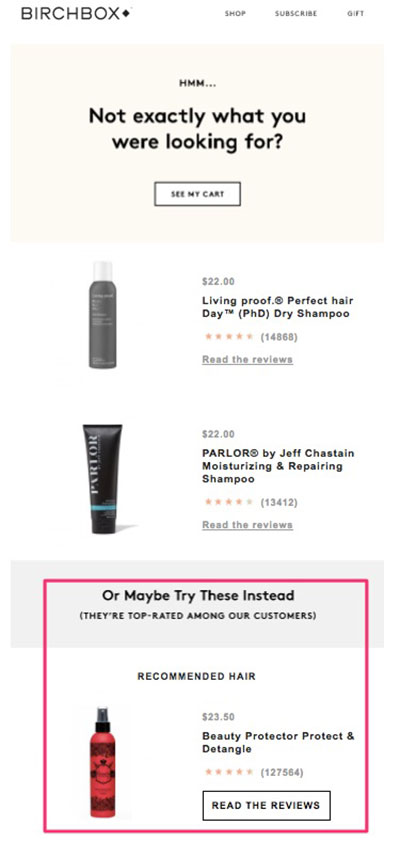
Customers who have items added to the cart are easiest to bring back because they're interested in your product and something stopped them. Do your best to encourage them to continue where they left.
-
New subscribers
Have you created a segment for new subscribers?
Don’t leave new subscribers alone because they need your attention more than anyone else.
A welcome email isn’t just enough, instead you need to show them what you have got. Your job should be to convert them into a customer as soon as possible.
Here is a welcome email from Michaels. See how smartly they introduced their brand, sent a welcome code, and also allowed subscribers to set preferences.
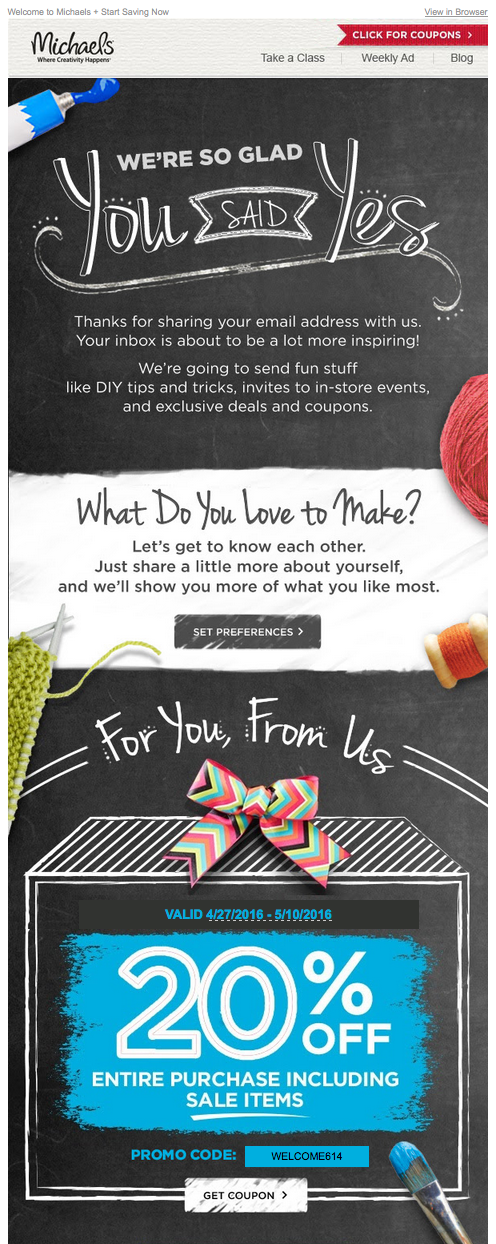
It is a perfect approach to converting subscribers into customers.
-
Inactivity
New subscribers and customers often become inactive for several reasons. Create segments for inactive subscribers and inactive customers.
Boden revives its relationship with its inactive customers by sending a really awesome email.
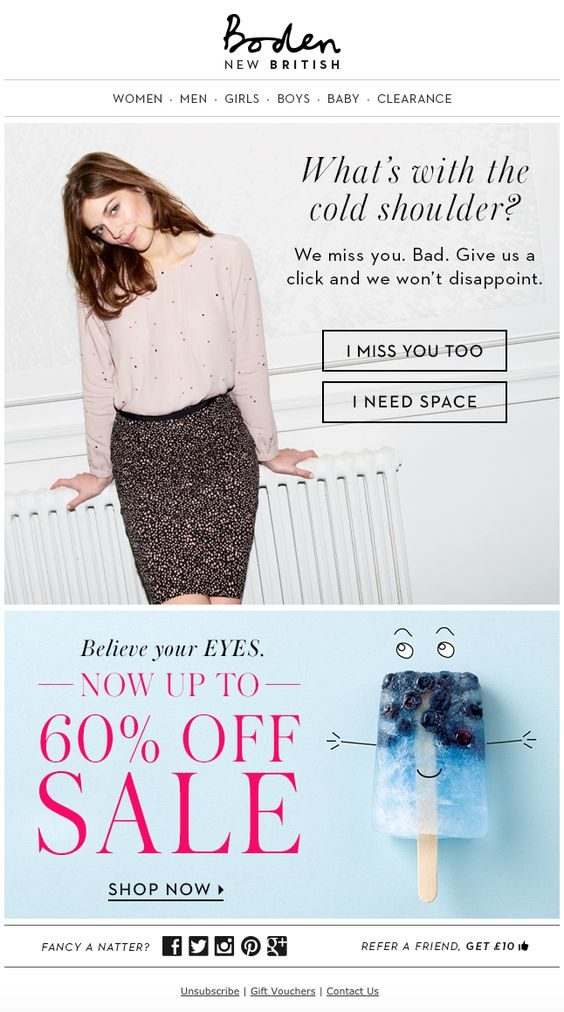
You can send a discount coupon to bring them back, like Mark and Graham.
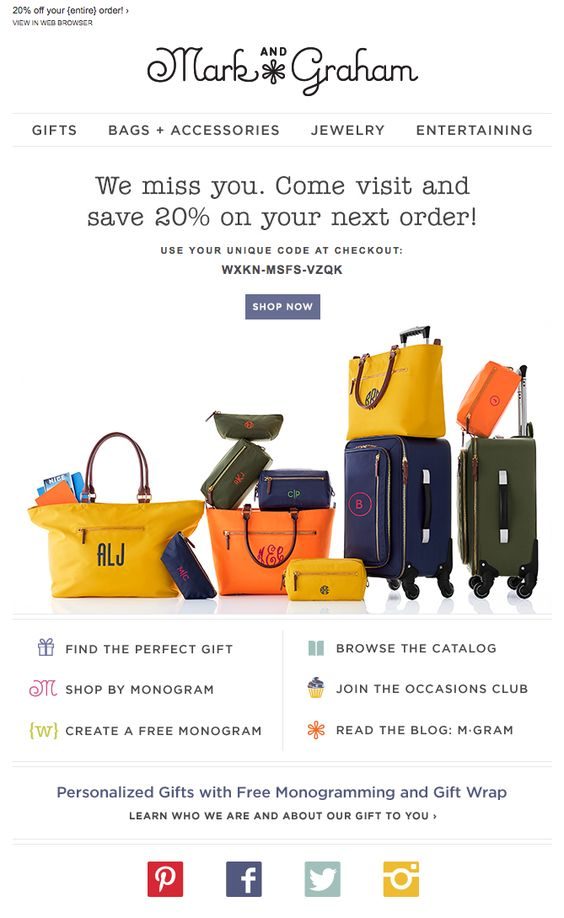
-
Form abandonment
Create a segment for subscribers who abandoned a form. This can only be achieved if your form is designed in a way that visitors have to submit their email address first.
If you don’t get their email address, you can’t get in touch.
Try bringing all those visitors back because they were once interested in your offer.
-
Sales funnel stage
Segmenting subscribers based on their stage in the sales funnel is important for two reasons:
- It generates sales.
- It is a must for overall marketing success.
The stage should determine what email a subscriber will receive and when and how he should be moved to another list.
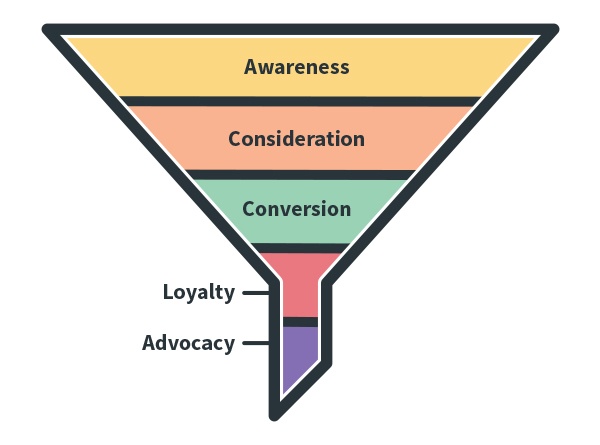
For instance, new subscribers should receive introductory and how-to emails while nurtured subscribers should receive emails compelling them to buy.
Here is how Harry’s educate its new subscribers.
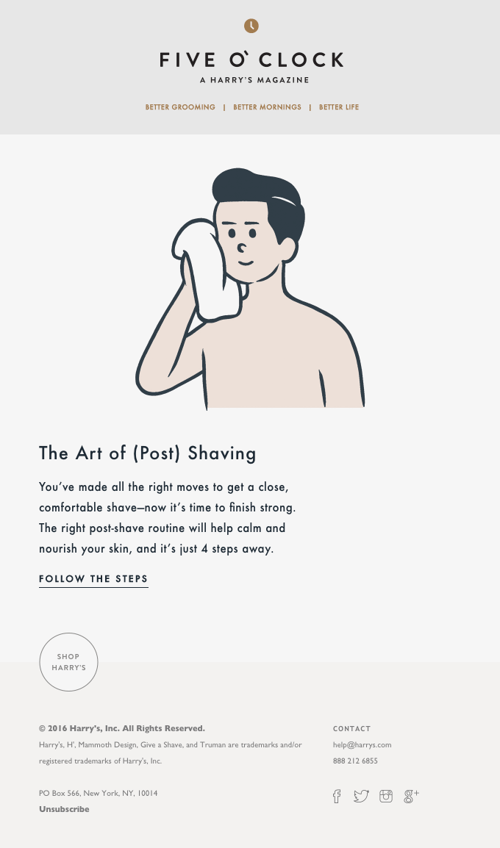
And then sends this email to convert them into customers.
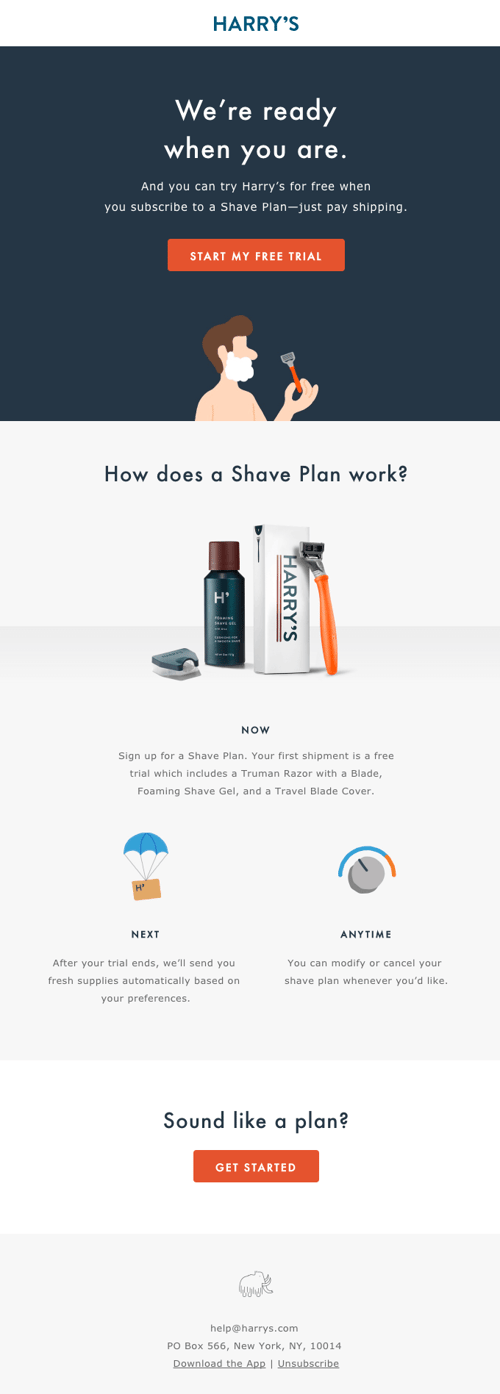
-
Coupon not used
Not all the coupons are redeemed. Sending a coupon expiry reminder will ensure that no coupon is wasted.
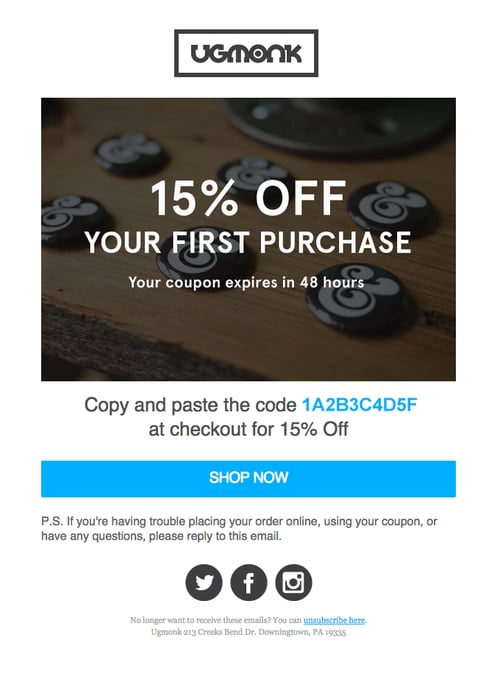
Whenever you create a coupon email campaign to target a specific list segment, make sure you add multiple emails with at least one coupon expiry reminder so as to increase redemption rate.
-
Recent purchase
The best time to generate more sales is when a customer has recently purchased from your store. That’s the time when you can convert a one-time buyer into a repeat customer.
Repeat customers are your store’s best asset as they spend 67% more than new customers.
Incentivize your customers to buy again from your store after they're done with a purchase.
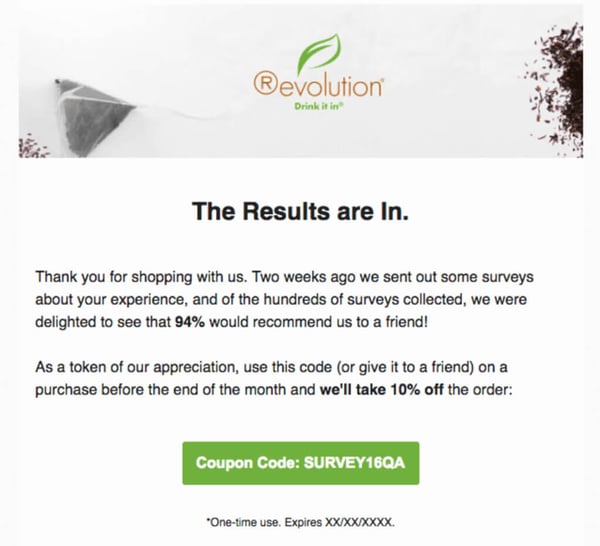
Better yet, integrate this email sequence with post-purchase email sequence so customers receive a series of emails after a purchase.
-
Weather
Is weather correlated to a specific product sales?
If it does, segmenting subscribers based on the weather in their area can be a great idea to generate sales.
Brooks Running Company used weather-based emails that helped them increase conversions by 61% and revenue per email increased by a whopping 95%.
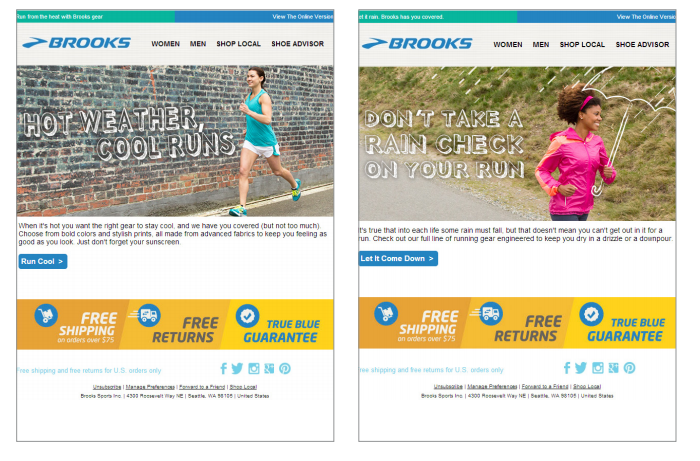
-
Amount spent
Amount your customers spent can be used to sell high-priced products. If you have expensive items in your store, you can pitch them to customers who spend significantly higher.
Similarly, you can pitch inexpensive products to customers who normally spend less.
-
Life events
How about sending emails that are related to your subscribers’ life? Life events include birthday, anniversary, wedding, promotion, and other special days.
This is an email that Joy will send you on your birthday.
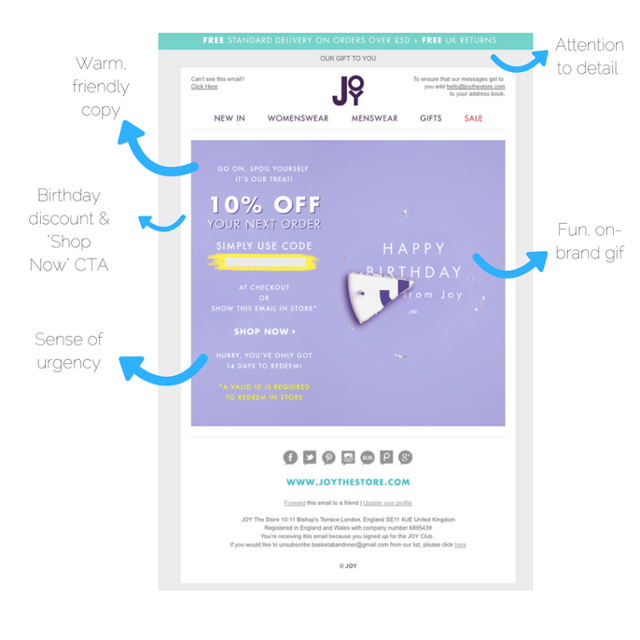
Not an ordinary birthday wish, they make it special by offering a discount coupon.
If you sell products online that people buy on special occasions such as bridal dresses, you can use this information to segment subscribers and proceed with targeted email sequence. Make their special day unforgettable by offering relevant products and discount coupons. And don’t forget to wish them.
Conclusion
List segmentation isn’t a one-off task. You have to keep finding new variables that impact sales, create relevant segments, and keep sending personalized emails. The whole point is to keep moving subscribers from one segment to another.
That’s how your store will never have issues generating sales.
Sabih Javed is an inbound marketer and a freelance writer who specializes in digital marketing. He has written content for several B2B companies and SaaS businesses. His work has appeared on sites like TheNextWeb, Yahoo News, Smart Data Collective, Business2Community, and more. You can read more about him on his blog DigitalMarketer.pk, and catch him on Twitter @sabihjavedd.
Want to learn more about using email marketing effectively? Download our free ebook below.


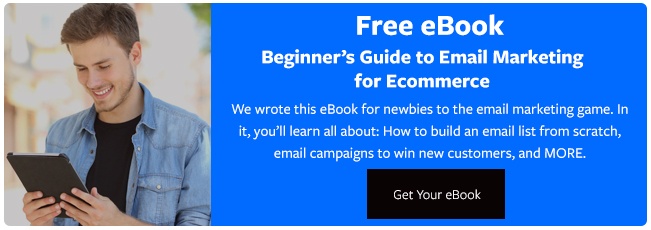


Leave a reply or comment below